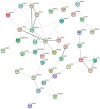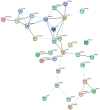Mechanistic Insights into the Anti-Proliferative Action of Gut Microbial Metabolites against Breast Adenocarcinoma Cells
- PMID: 37894734
- PMCID: PMC10606851
- DOI: 10.3390/ijms242015053
Mechanistic Insights into the Anti-Proliferative Action of Gut Microbial Metabolites against Breast Adenocarcinoma Cells
Abstract
The gut microbiota undergoes metabolic processes to produce by-products (gut metabolites), which play a vital role in the overall maintenance of health and prevention of disease within the body. However, the use of gut metabolites as anticancer agents and their molecular mechanisms of action are largely unknown. Therefore, this study evaluated the anti-proliferative effects of three key gut microbial metabolites-sodium butyrate, inosine, and nisin, against MCF7 and MDA-MB-231 breast adenocarcinoma cell lines. To determine the potential mechanistic action of these gut metabolites, flow cytometric assessments of apoptotic potential, reactive oxygen species (ROS) production measurements and proteomics analyses were performed. Sodium butyrate exhibited promising cytotoxicity, with IC50 values of 5.23 mM and 5.06 mM against MCF7 and MDA-MB-231 cells, respectively. All three metabolites were found to induce apoptotic cell death and inhibit the production of ROS in both cell lines. Nisin and inosine indicated a potential activation of cell cycle processes. Sodium butyrate indicated the possible initiation of signal transduction processes and cellular responses to stimuli. Further investigations are necessary to ascertain the effective therapeutic dose of these metabolites, and future research on patient-derived tumour spheroids will provide insights into the potential use of these gut metabolites in cancer therapy.
Keywords: breast cancer; gut microbial metabolites; gut microbiome; inosine; nisin; postbiotics; sodium butyrate.
Conflict of interest statement
As a medical research institute, NICM Health Research Institute receives research grants and donations from foundations, universities, government agencies, individuals, and industry. Sponsors and donors also provide untied funding for work to advance the vision and mission of the institute. The authors report no conflict of interest.
Figures





Similar articles
-
The postbiotic sodium butyrate synergizes the antiproliferative effects of dexamethasone against the AGS gastric adenocarcinoma cells.Front Nutr. 2024 Mar 12;11:1372982. doi: 10.3389/fnut.2024.1372982. eCollection 2024. Front Nutr. 2024. PMID: 38533461 Free PMC article.
-
Gut Metabolites and Breast Cancer: The Continuum of Dysbiosis, Breast Cancer Risk, and Potential Breast Cancer Therapy.Int J Mol Sci. 2022 Aug 22;23(16):9490. doi: 10.3390/ijms23169490. Int J Mol Sci. 2022. PMID: 36012771 Free PMC article. Review.
-
Sodium butyrate promotes apoptosis in breast cancer cells through reactive oxygen species (ROS) formation and mitochondrial impairment.Lipids Health Dis. 2017 Nov 2;16(1):208. doi: 10.1186/s12944-017-0593-4. Lipids Health Dis. 2017. PMID: 29096636 Free PMC article.
-
Gut microbiota-derived inosine from dietary barley leaf supplementation attenuates colitis through PPARγ signaling activation.Microbiome. 2021 Apr 5;9(1):83. doi: 10.1186/s40168-021-01028-7. Microbiome. 2021. PMID: 33820558 Free PMC article.
-
Sodium butyrate in both prevention and supportive treatment of colorectal cancer.Front Cell Infect Microbiol. 2022 Oct 26;12:1023806. doi: 10.3389/fcimb.2022.1023806. eCollection 2022. Front Cell Infect Microbiol. 2022. PMID: 36389140 Free PMC article. Review.
Cited by
-
Anti-Colon Cancer Effects of Lysate from Potential Probiotic Yeast Strains Derived from Human Breast Milk.Probiotics Antimicrob Proteins. 2024 Dec 4. doi: 10.1007/s12602-024-10410-4. Online ahead of print. Probiotics Antimicrob Proteins. 2024. PMID: 39627436
-
Investigating the Cellular Responses to Combined Nisin and Urolithin B Treatment (7:3) in HKB-11 Lymphoma Cells.Int J Mol Sci. 2025 Jul 30;26(15):7369. doi: 10.3390/ijms26157369. Int J Mol Sci. 2025. PMID: 40806497 Free PMC article.
-
Platinum-based metal complexes as chloride transporters that trigger apoptosis.Chem Sci. 2024 Jun 26;15(29):11584-11593. doi: 10.1039/d4sc02115k. eCollection 2024 Jul 24. Chem Sci. 2024. PMID: 39055016 Free PMC article.
-
Gut Microbial Postbiotics as Potential Therapeutics for Lymphoma: Proteomics Insights of the Synergistic Effects of Nisin and Urolithin B Against Human Lymphoma Cells.Int J Mol Sci. 2025 Jul 16;26(14):6829. doi: 10.3390/ijms26146829. Int J Mol Sci. 2025. PMID: 40725093 Free PMC article.
-
The postbiotic sodium butyrate synergizes the antiproliferative effects of dexamethasone against the AGS gastric adenocarcinoma cells.Front Nutr. 2024 Mar 12;11:1372982. doi: 10.3389/fnut.2024.1372982. eCollection 2024. Front Nutr. 2024. PMID: 38533461 Free PMC article.
References
MeSH terms
Substances
LinkOut - more resources
Full Text Sources
Miscellaneous

